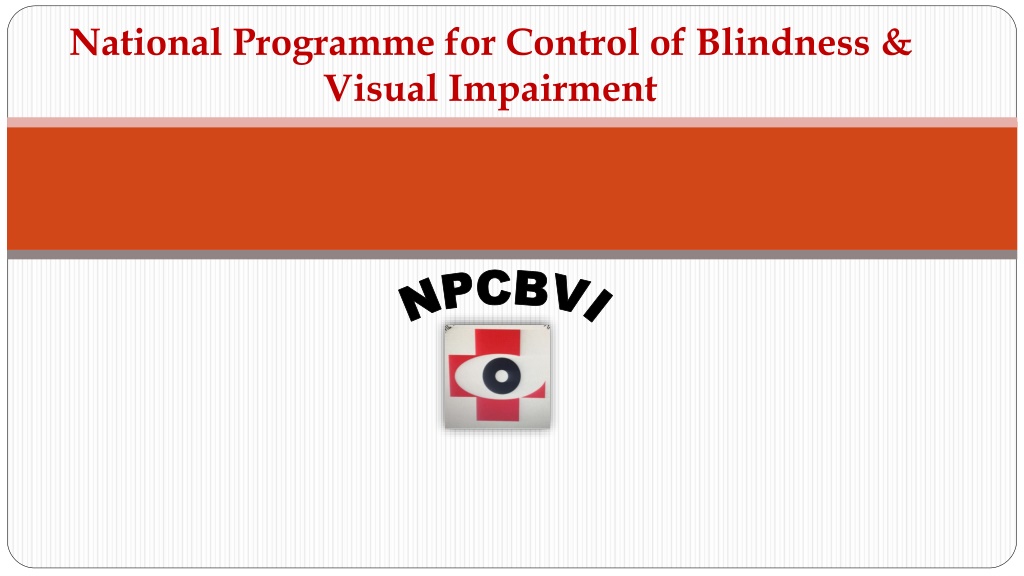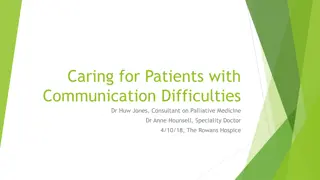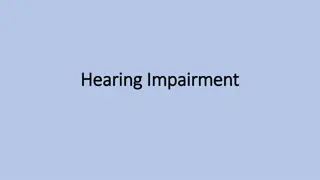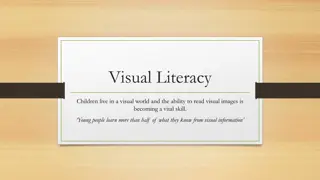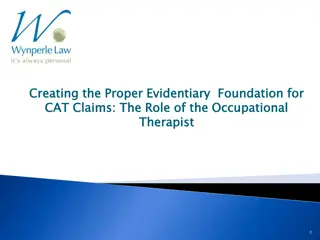National Programme for Control of Blindness & Visual Impairment Overview
The National Programme for Control of Blindness & Visual Impairment (NPCBVI) is a government initiative aimed at reducing the prevalence of avoidable blindness in India. Launched in 1976, the program focuses on providing comprehensive eye care services, developing human resources, enhancing community awareness, and reducing the backlog of blindness. With a goal to reduce blindness prevalence to 0.3% by 2020, NPCBVI addresses major causes of blindness such as cataracts, refractive errors, and glaucoma. The program's activities include free cataract surgeries, eye screenings, eye bank services, diagnosis and treatment of eye diseases, and training of medical personnel. NPCBVI strives to improve eye health services and increase access to quality eye care across the country.
Download Presentation

Please find below an Image/Link to download the presentation.
The content on the website is provided AS IS for your information and personal use only. It may not be sold, licensed, or shared on other websites without obtaining consent from the author. Download presentation by click this link. If you encounter any issues during the download, it is possible that the publisher has removed the file from their server.
E N D
Presentation Transcript
National Programme for Control of Blindness & Visual Impairment NPCBVI
Introduction National Programme for Control of Blindness (NPCB) launched in 1976.The Trachoma Control Programmestarted in 1963 was merged under NPCB in 1976. In the beginning, NPCB was a 100% centrally sponsored programme (now from 12th FYP it is 60:40 in all States/UTs and 90:10 in hilly states and all NE States). Nomenclature of the programme was changed from National Programme for Control of Blindness to National Programme for Control of Blindness & Visual Impairment (NPCBVI) in 2017.
Burden of Blindness Prevalence of Blindness - 1.1%. (Blindness Survey 2001-02). Prevalence of Blindness 1.0%. (Blindness Survey 2006-07). Blindness Survey (2015-18) completed. Findings to be released shortly. WHO Goal reduction of prevalence of avoidable blindness to 0.3% by 2020. NHP target to reduce the prevalence of blindness to 0.25% by 2025 and disease burden by one third from current levels. Causes of Blindness Cataract (62.6%) Refractive Error (19.70%) Glaucoma (5.80%) Posterior Segment Disorder (4.70%) Surgical Complication (1.20%) Posterior Capsular Opacification (0.90%) Corneal Blindness (0.90%) Others (4.19%)
Goals & Objectives of the Programme Goal To reduce the prevalence of blindness to 0.3% by the year 2020 Objectives Reduce the backlog of blindness through identification and treatment of blind. Develop comprehensive eye-care facilities at each level i.e. PHCs, CHCs, Dist. Hospitals, Medical Colleges and Regional Institutes of Ophthalmology. Develop human resources for providing Eye Care Services. Improve quality of service delivery. Secure participation of Voluntary Organizations/Private Practitioners in eye care services. Enhance community awareness on eye care.
Summary of Programme activities Summary of Programme activities NHM Component S. No Activities 1 Free Cataract Surgery at district hospitals and identified NGO eye hospitals/ Pvt. Practitioners Eye Screening and Distribution of Free spectacles to School children and elderly 2 3 Collection of Donated Eyes through network of eye banks and eye donation centres 4 Diagnosis and Treatment of other eye diseases (glaucoma, childhood blindness, squint etc.) at District Hospitals and identified NGO eye hospitals Procurement and maintenance of Ophthalmic equipments at sub-district/district Hospitals and Vision Centres (in public sector only from FY 2018-19). 5 6 Training of Para Medical Ophthalmic Assistants posted at PHC/ District Hospitals 7 8 Strengthening of eye banks (in public sector only from FY 2018-19). IEC activities on promoting eye health, preventing eye diseases and increasing utilization of services.
Summary of Programme activities Summary of Programme activities Tertiary Eye Care Components S. No Activities 1 Provision of super specialty and referral eye care services for diabetic retinopathy, Glaucoma, childhood blindness, retinopathy of prematurity and Keratoplasty (corneal transplantation) etc. at Regional Institutes of Ophthalmology and Medical Colleges. 2 Construction of modular Eye OTs at RIOs for providing modern and tertiary level eye care services 3 Training of eye surgeons in various specialties of Ophthalmology for skill development 4 Provision for supply of MK Medium to Govt. Eye Banks through Dr. R.P.Centre, AIIMS, New Delhi for preservation of donated corneas and improve corneal utility rate. 5 Conducting Surveys (blindness & Visual Impairment Survey, Trachoma Survey etc.) through identified institutions.
Physical Performance Physical Performance Total No. of Cataract Surgery Total No. of Cataract Surgery No. of Cataract operations performed 64,81,435 64,41,487 66,85,476 16,46,921 % Year Target Achievement 98 97 101 2016-17 2017-18 2018-19 2019-20* 66,00,000 66,00,000 66,00,000 67,00,000 Distribution of free spectacles under School Eye Screening Distribution of free spectacles under School Eye Screening No. of free spectacles provided to school children suffering from refractive errors % Achievement Year Target 9,00,000 9,00,000 9,00,000 10,00,000 Achievement 7,57,906 7,98,411 8,79,488 82,590 2016-17 2017-18 2018-19 2019-20* 84 88 97
Physical Performance Physical Performance Collection of donated Eyes for corneal transplantation Collection of donated Eyes for corneal transplantation No. of donated eyes collected Target 50,000 50,000 55,000 70,000 % Achievement Year Achievement 65,135 71,709 68,007 19,950 2016-17 2017-18 2018-19 130 143 123 2019-20* Treatment/management of other eye diseases Treatment/management of other eye diseases (Diabetic retinopathy, glaucoma, childhood blindness, (Diabetic retinopathy, glaucoma, childhood blindness, keratoplasty keratoplasty etc.) etc.) % 562 761 307 31.42 Year Target 72,000 72,000 2,00,000 6,00,000 No. of Cases treated 4,04677 5,48,448 6,14,433 1,88,507 2016-17 2017-18 2018-19 2019-20* * The physical progress report for the year 2019-20 is provisional
Physical Performance Physical Performance Training of Eye Surgeons: Training of Eye Surgeons: No. of eye surgeons trained in various specialties of ophthalmology Year 2016-17 2017-18 2018-19 2019-20 121 125 129 40 Training / Training / Workshops Workshops All State & District Program Officers and Ophthalmologists were trained in diagnosis and treatment of Trachoma in 9 previously trachoma endemic States/UTs 450 Ophthalmologist were trained in two days workshops in early diagnosis and treatment of Glaucoma during 2016-17 & 2017-18.
Major issues Major issues Low utilization of allotted funds by most of the States except Chhattisgarh and Sikkim Poor physical performance by many states Nagaland, Sikkim, Lakshadweep, Meghalaya, J & K and Jharkhand. Delay in NGO payments (for performing cataract and treatment of other eye diseases) by District Programme Officers inspite of their uploading of data in the MIS of NPCBVI. Quality issue: Sporadic episodes of cluster enophthalmities keep coming inspite of circulation of prescribed eye surgery guidelines. Poor nominations for training: Very few nominations of eye specialists are sent by States for refresher hands on training. This results in inadequate skilled/trained eye surgeons in States. Many of the States do not have sanctioned posts of Ophthalmologists at district level.
Major issues concerning RIOs Utilization certificate for the grant are awaited from most of the RIOs (except Patna and Cuttack). All RIOs need to develop Modular Eye OTs for providing superspeciality eye care services All RIO need to conduct training eye surgeons in superspeciality eye care Need for setting up of eye banks and improvement in Keratoplasty services Physical progress reports has been received from 6 RIOs only.
Innovations under NPCBVI Introduction of tele-ophthalmology in eye care. Linkage of lower units (PHC/vision centres) with nearby higher units (district hospitals/Medical Colleges) for coverage of hilly and hard to reach areas (Tripura, Andhra Pradesh, Tamila Nadu). Initiating Diabetic Retinopathy Projects at Karnataka, Tamil Nadu, West Bengal, Madhya Pradesh, Maharashtra etc.). Corneal Blindness Backlog free initiative in Punjab. Use of digital media in IEC. 12
Funds released to Regional Institutes of Ophthalmology Funds released to Regional Institutes of Ophthalmology (RIOs) (RIOs) Rs. In Lakhs Sl. No. Name RIOs through respective State Health Society 1 RIO, Patna, Bihar 2013-14 2014-15 2016-17 2017-18 Grand Total From 2013-14 to 2017-18 100.00 100.00 2 3 4 5 6 7 8 9 RIO, Ahmedabad, Gujarat RIO, Guwahati, Assam RIO, Amritsar, Punjab RIO, Thiruvananthapuram, Kerala RIO, Kolkata, West Bengal RIO, Minto RIO Bangalore, Karnataka RIO, Srinagar,J& K RIO, Cuttack, Odisha RIO, Dr.R.P.Centre,Delhi 100.00 100.00 100.00 300.00 200.00 100.00 100.00 100.00 200.00 300.00 100.00 100.00 300.00 600.00 300.00 100.00 100.00 0.00 100.00 300.00 200.00 10
Funds released to RIOs under (NPCB&VI) Funds released to RIOs under (NPCB&VI) Rs. In Lakhs Sl. No. Name of Society (RIOs) 2013-14 2014-15 2016-17 2017-18 Grand Total From 2013-14 to 2017- 18 100.00 300.00 0.00 300.00 200.00 200.00 100.00 200.00 500.00 3900.00 11 12 13 14 15 16 17 18 19 RIO, Chennai RIO, Allahabad RIO, Bhopal M.P. RIO, Raipur,Chhattisgarh RIO, Jaipur,Rajasthan RIO, Ranchi, Jharkhand RIO Rohtak, Haryana R.IO Mumbai,Maharashtra RIO, Hyderabad Telangana Total 100.00 100.00 200.00 100.00 200.00 200.00 200.00 100.00 200.00 200.00 1900.00 300.00 1500.00 100.00 400.00 * During FY: 2015-16 and 2018-19 no funds were released.
